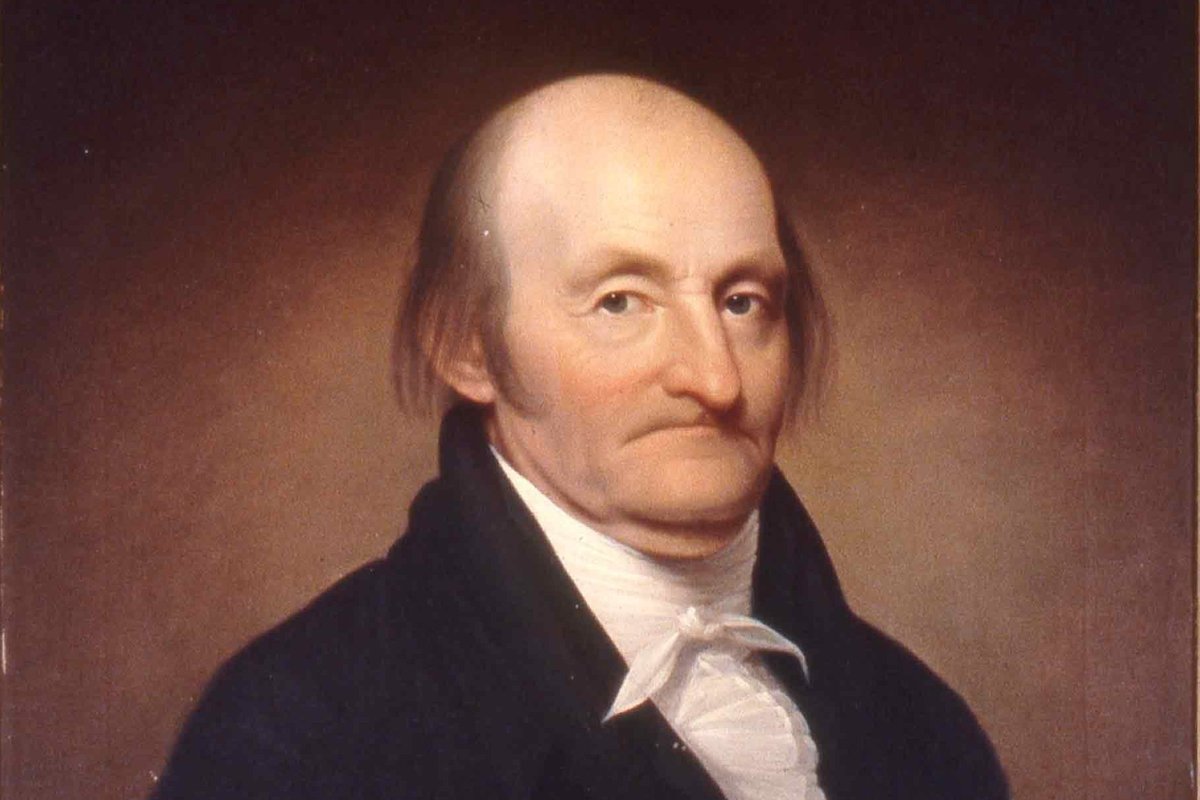
Who was James McClurg?
The first thing many guests notice when they walk onto the Custis Square archaeological site is the small brick kitchen sitting towards the East of the property. Formerly known as “Martha’s Kitchen,” archaeology and research have shown that this is not a kitchen that belonged to Martha Washington. It did not even belong to John Custis IV. Built on top of the original 18th-century kitchen foundations, this building was constructed by a man named Dr. James McClurg. Now known as the “McClurg Kitchen,” it was thought to be constructed sometime in the early 19th century.
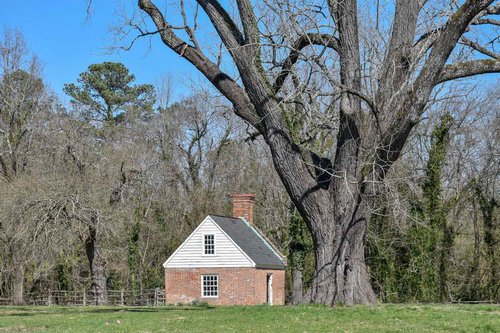
The McClurg Kitchen
So who was James McClurg? Visitors do not usually recognize his name.
Though largely forgotten today, Dr. James McClurg was a well-known physician in Virginia during the late eighteenth and early nineteenth centuries. He was a professor at the College of William and Mary and in correspondence with many well-known figures in Williamsburg: St. George Tucker, Thomas Jefferson, and George Wythe. McClurg was even a delegate to the Confederation Congress and mayor of Richmond for three years. Although his name is not as recognizable as Jefferson or Wythe, McClurg played a significant role in American and Virginia history. He also was a resident at Custis Square during the late eighteenth century.
What did McClurg do on the Site?
As the standing kitchen on Custis Square is attributed to McClurg, there may have been other construction while he was living on the property. He no doubt was purchasing goods in town and corresponding with many people. Having an idea of who McClurg was can give us an understanding of what he was doing in Williamsburg, what kind of work was done at Custis Square, and the kinds of material goods he might have owned.
James McClurg was not the only resident on Custis Square while he was in Williamsburg. He married Elizabeth Selden in 1779 and had at least one child (Elizabeth Selden McClurg Wickham) with her. McClurg also enslaved several individuals while on the property, whose lives are unknown.
Early Life in Williamsburg and Abroad
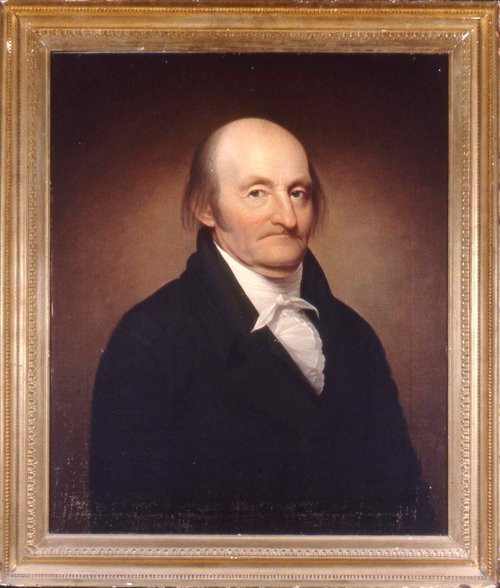
Dr. James McClurg, Painted by Cephas Thompson, Circa 1810. Photo courtesy The Valentine.
McClurg was born in 1746 in the Hampton, Virginia, area to Dr. Walter McClurg, a British naval surgeon who worked there at the time. His mother is unknown. McClurg attended William and Mary until 1762 for his formal education. During his time there, he met fellow student Thomas Jefferson. They became friends during this time and later correspondenceds. Although Wyndham Blanton, who wrote an extensive book on medicine in Virginia during the eighteenth century, praised McClurg for his achievements in learning there, he was once suspended for “injurious behaviour” towards residents in the town.1 Whatever crime McClurg may have committed, he was eventually forgiven, his reputation was not harmed, and he was able to complete his education.
After he finished at William and Mary, McClurg traveled abroad to Europe. His first stop was the University of Edinburgh. McClurg received his medical training as a physician here, as did may other Virginia physicians. McClurg finished his time at Edinburgh in 1770 with a thesis titled “De Calore” and then traveled to Paris and London to continue his studies into medicine and surgery. He published his most famous work during that time in London: Experiments upon the Human Bile: And Reflections on the Biliary Secretions. After this publication in 1772, McClurg went home to Virginia.
A Member of Society in Williamsburg
James McClurg returned to Williamsburg by 1773. His exact travels in the state are not very clear, but the first sign of him in Williamsburg was an advertisement in Purdie and Dixon’s Virginia Gazette. In the May 27 and June 3 editions, McClurg posted an advertisement for the sale of a few copies his Experiments upon the Human Bile. Although McClurg likely lived in Williamsburg at this time, it is unclear where in town he might have resided for the early part of his time in the city.
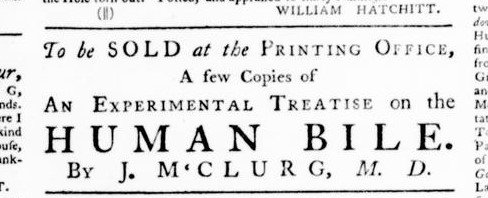
The Virginia Gazette, Purdie and Dixon, June 3, 1773; part of the Colonial Williamsburg collection
McClurg quickly became a part of society in Williamsburg and joined many different organizations. One of the first he joined was the Free Masons. His first listed meeting was on August 21, 1773. McClurg was passed and raised in the Masons on Dec. 22, 1774, and was elected as a senior warden in 1777. He was appointed Junior Warden of the Stewards Lodge at the first Grand Lodge in 1778 and was a delegate from Williamsburg Lodge in Grand Lodge on Oct 28, 1785. McClurg also joined the Virginia Society for the Promotion of Useful Knowledge, which was founded in 1773 and lasted until around the time of the Revolutionary War. It is clear from his memberships to these organizations that McClurg was becoming a prominent figure in Williamsburg, especially among well-educated men.
Practice of Medicine
While living in Williamsburg, McClurg chose to practice medicine strictly as a physician, diagnosing patients and prescribing treatment. When the Revolutionary War broke out, McClurg offered his service to the Continental Army. When he heard of a position for a physician for the army, he wrote to his friend Thomas Jefferson on April 6th, 1776:
If this should find you at Congress, when the business it relates to is undetermined, I hope you will use your Influence in favor of your humble Servant. It is believ’d here that a Physician will be appointed to the Continental Troops in this Colony; an office that I desire Exceedingly, as it would gratify at the same time my passion for Improvement in the profession I am destined to, and my zeal to do my Country some Service. In this time of general activity, I do not like to be an idle Spectator; and I know not any post which would suit me so well.
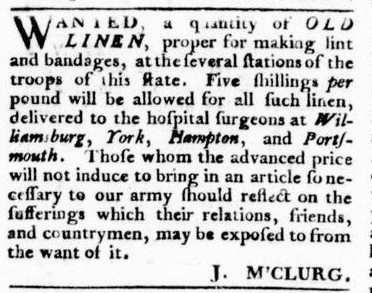
The Virginia Gazette, Purdie, September 5th, 1777; ; part of the Colonial Williamsburg collection
Although Jefferson and others supported the nomination of McClurg, the Continental Congress gave the post to another man. McClurg still worked for the military hospitals as a surgeon in Hampton, however. During that time, the situation becaome somewhat dire for the workers at the hospitals. McClurg placed an ad in the September 5, 1777, edition of Purdie’s Virginia Gazette for old linen to use as bandages at the hospitals in Williamsburg, York, Hampton, and Portsmouth. The issue of pay became a prominent complaint as well. McClurg applied to the governor and Council in Virginia in 1779 for higher pay and rations for those working in as surgeons in the Virginia hospitals.
While working as a surgeon in the army in December 1779, McClurg’s friend James Madison gave him the inaugural professorship of anatomy and medicine
James McClurg was given the post of the first Professor of Anatomy and Medicine at William and Mary in December 1779. By 1780, he wrote again to his connections in the government, and he was finally promoted to a naval surgeon in Hampton, which provided him a boost in his pay and rations. Near the end of the war in 1781, he may have even been promoted further to the position of physician of the Continental Army (the post to which he originally applied), but his exact title and promotions are not well documented. These higher-ranking positions during the war gave McClurg more fame and recognition. By 1783, McClurg left the position of Professor of Anatomy and Medicine as he moved to Richmond. As he was occupied for much of his professorship by the Revolutionary War, it is unclear how much he taught while in his position as professor. The post was not filled after he left the school.
Purchase of Custis Square
McClurg did not officially own Custis Square until 1779. He may have rented the place as early as 1774 or 1775. When John Parke Custis wrote of the lot in 1778, however, he described it as not being fit for living. He sold the lot by December and McClurg most likely bought it by January of 1779. The property was extensively repaired that year.
While he lived at Custis Square, McClurg married a woman named Elizabeth Selden who was from Hampton. Their marriage was announced in the Virginia Gazette, but with little detail. They had a child together in 1781 named Elizabeth Selden McClurg.
Near the end of the Revolutionary War, the British Army came near Williamsburg, and there were reports of disease and destruction. Some of McClurg’s enslaved people apparently left him at this point, as St. George Tucker recorded that McClurg “has one small servant left, and but two girls. He feeds and saddles his own horse and is philosopher enough to enjoy the good that springs from the absence of the British without repining at what he lost by them.”5 McClurg may have lost more than enslaved people during the war. In 1783, McClurg’s property was once again extensively repaired. This may have been intended to repair damages caused by British quartering. It may have also been intended to prepare Custis Square for rental as he moved to Richmond. No records document who McClurg may have rented the property to.
McClurg's Later Life
Both in 1779 and 1780, McClurg complained about low pay while working as a surgeon. This may have influenced McClurg’s switch towards a life of politics. A letter written to Thomas Jefferson on May 17, 1781, suggests that Jefferson attempted to persuade McClurg to study the law. McClurg’s response clearly shows that he was entertaininged the idea of switching careers. He wrote to Jefferson again in 1784 of and commented that a government office would be “infinitely more agreeable” than his current work, which was “irksome, fatiguing and very little profitable.” Despite these complaints, he owned a substantial amount of property for the time, including seven enslaved people, two horses, and three cattle in 1784.
McClurg continued his life as both a renowned physician and politician. He was a member of the Virginia delegation to the Confederation Congress. He also became the Mayor of Richmond in 1797, 1800, and 1803. McClurg continued to practice medicine while in Richmond. He was appointed president of the Medical Society of Virginia in 1820. McClurg died in 1823 and was buried at St. John’s Episcopal Churchyard in Richmond.
Sources
- “Journal of the Meetings of the President and Masters of William and Mary College,” William and Mary College Quarterly Historical Magazine 4 (July 1895): 44.
